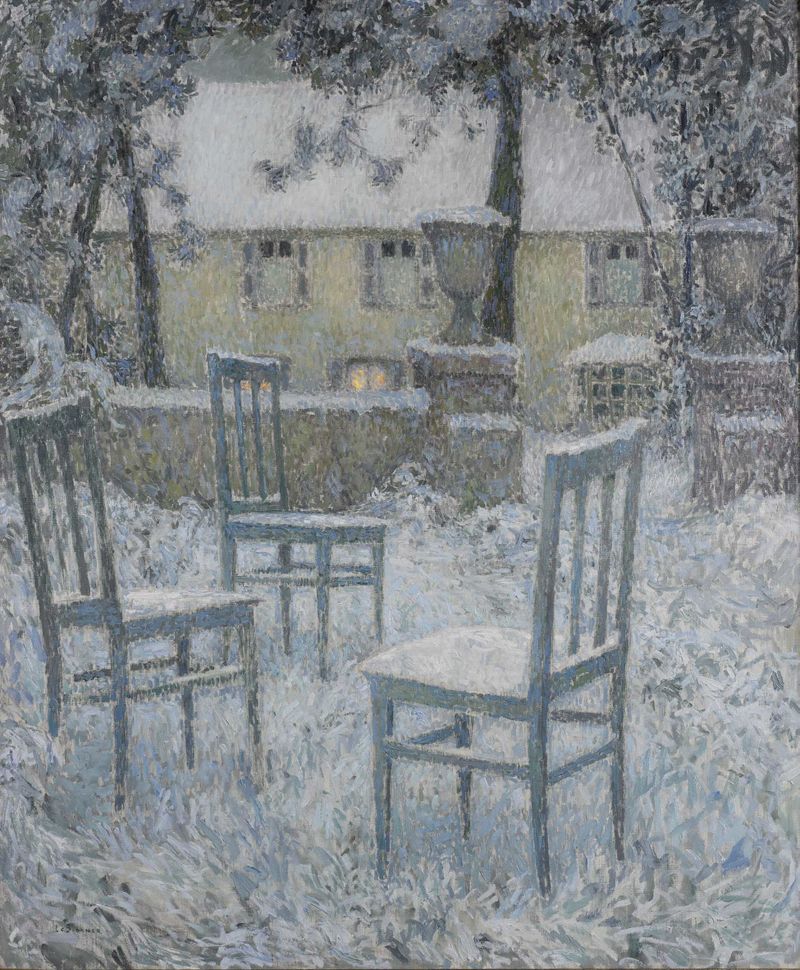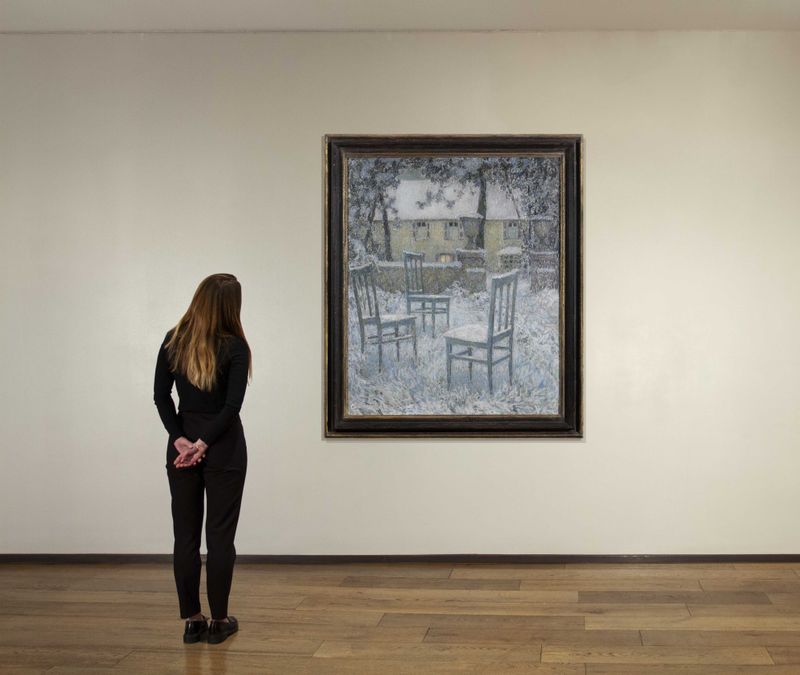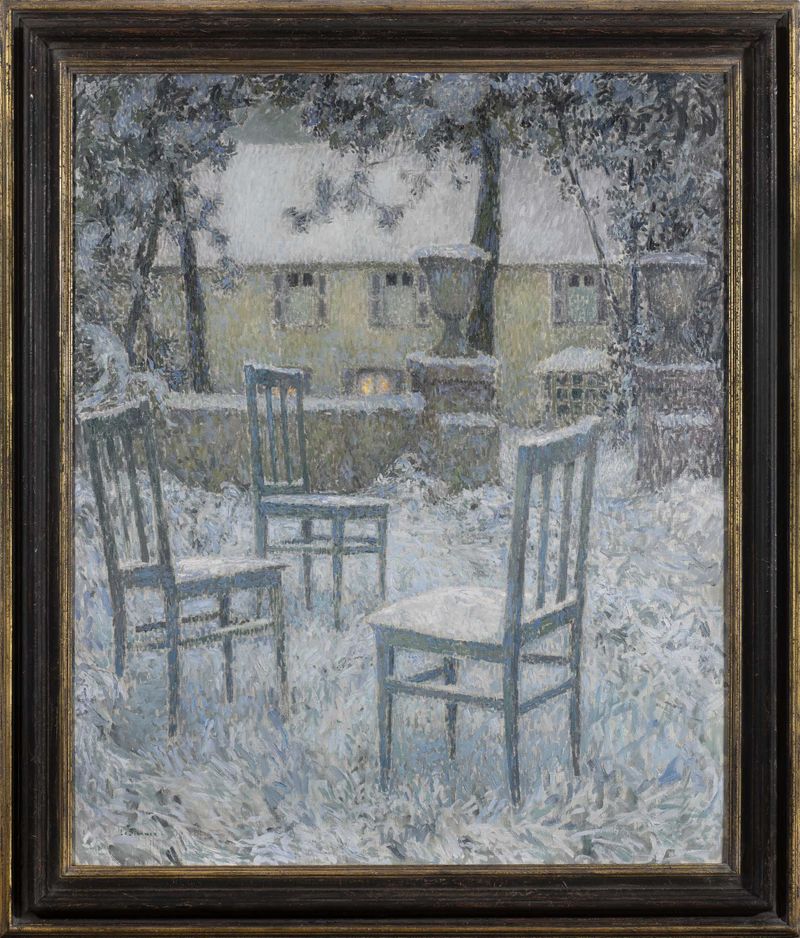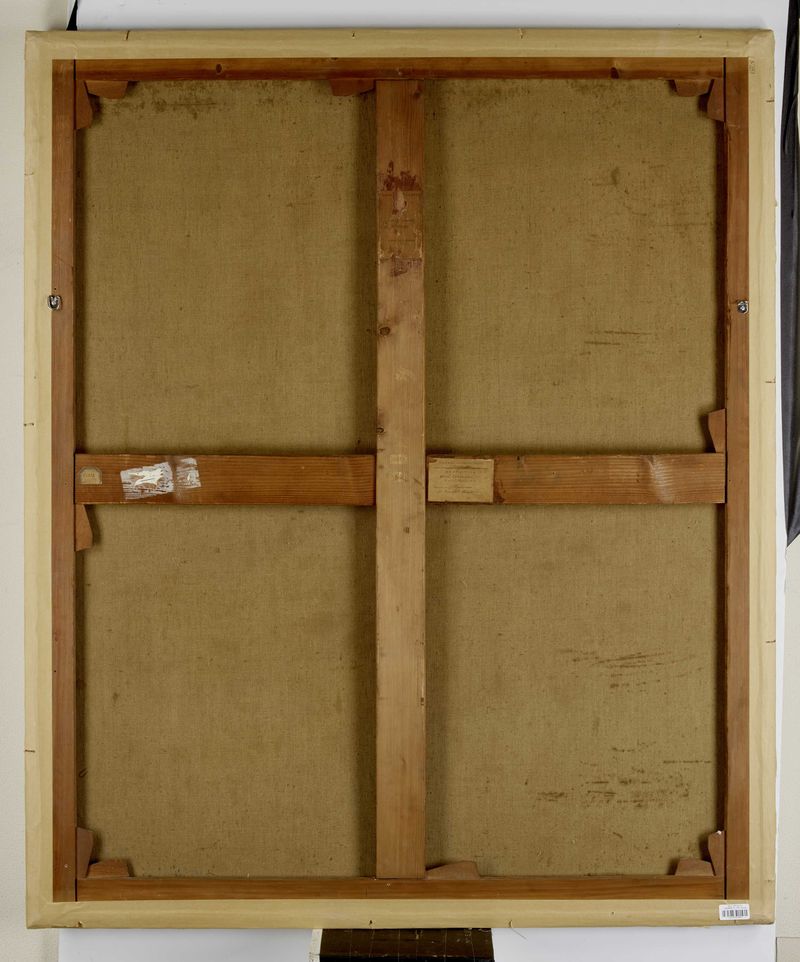Henri Le Sidaner
(French, 1862-1939)
Neige
1924
oil on canvas
150 x 125 cm (59 x 49 in.)
signed ‘Le Sidaner’ (lower left)
Galerie Georges Petit, Paris (no. 7690 & 10.427)
Emile Prat, Fontanes
Louis Le Sidaner (the artist’s son, acquired from the above)
Private collection
Sale: Sotheby's New York, 17 November 1998, lot 287
Private collection, USA (acquired at the above sale)
C. Mauclair, Henri Le Sidaner, Paris, 1928, pp. 139 & 260 (illustrated)
Y. Farinaux-Le Sidaner, Le Sidaner: l'oeuvre peint et gravé, Paris, 1989, p. 206, no. 537 (illustrated)
Y. Farinaux-Le Sidaner, Henri Le Sidaner - Paysages intimes, 2013, p. 232
Paris, Salon des Tuileries, 1924, no. 962
Paris, Galerie Georges Petit, Exposition Le Sidaner, 1925, no. 4
“Three forgotten chairs on the terrace, in the thick snow. At the bottom, beyond two vases, one end of the house, its roof is heavy with white, a lighted window, a single note of warm tone in this dismal symphony of gray and white: and it's all winter sleepiness” - C. Mauclair
More artworks by Henri Le Sidaner ▶
Additional Notes:
Henri Le Sidaner is renowned for his serene and intimate outdoor still life scenes featuring a deserted table and chairs with hints of the human figures recently removed. Art critic Camille Mauclair wrote of Le Sidaner: "He considered that the silent harmony of things is enough to evoke the presence of those who live among them. Indeed, such presences are felt throughout his works. Deserted they may be but never empty" (C. Mauclair, Henri Le Sidaner, Paris, 1928, p. 12).
Neige is representative of Le Sidaner's mature style and incorporates elements from the several movements that characterized and influenced the artist's career. The present work embodies the Intimist artistic movement, as defined by Mauclair: "A revelation of the soul through the things painted, the magnetic suggestion of what lies behind them through the description of the outer appearance, the intimate meaning of the spectacles of life. This intimate meaning is not exactly the symbolism or the mysticism of the primitives or of the allegorists of the Renaissance, who combined natural elements from the point of view of personal conception. It confines itself to expressing so much of their depth as objects and beings, as we perceive them, allow us to divine—the daily tragedy and mystery of ordinary existence, and the latent poetry of things" (C. Mauclair, The Great French Painters and the Evolution of French Painting from 1830 to the Present Day, London, 1903, p. 122).
The trajectory from Impressionism to Intimism is clear in the latter movement's application of the staccato brushstrokes and focus on play of light, but Intimism abandoned an interest in accuracy of perspective and colour in favour of merging figure and ground and an exaggerated colour palette. Such compositional structure is evident in the present work, which is a striking example of Le Sidaner's delicate play with optics. Here, amidst the snow fall, three chairs are situated in a conversational circle, with the chairs at far left and furthest in the back tilted slightly to suggest their occupants only just vacated. Le Sidaner's acute understanding of velvety darkness comingling with sparkles of light is stunningly conveyed in his subtly cascading snowflakes during twilight. There is a slight forward tilt to the entire scene, thereby suggesting a confluence between the foreground garden seats with the house glimmering behind. It is with great care that Le Sidaner composed such a still life to convey the palpable, invisible human presence that lends his paintings their intimacy. "These familiar objects supplied in the absence of people make one think that people have just left, and are nearby, or will return to lend the objects an animation that was only temporarily absent" (C. Lévy-Lambert, "L'oeuvre de Henri Le Sidaner" in Henri Le Sidaner (exhibition catalogue), Musée Marmottan, Paris, 1989, p. 31).
Le Sidaner's garden at his home in Gerberoy, where this work was painted, provided the artist seemingly endless inspiration. Le Sidaner first visited Gerberoy in March 1901 in search of a proper country home to escape to from Paris. His son Rémy later reflected that his father "longed to plan a garden of his own, in which the landscape would be designed by him personally and in which he could achieve his favourite light effects. He mentioned this project to Auguste Rodin, who directed him to the Beauvais area. A potter living in Beauvais, answering to the name of Delaherche, recommended the village of Gerberoy" (quoted in Y. Farinaux-Le Sidaner, Le Sidaner, L'oeuvre peint et gravé, Milan, 1989, p. 14). Le Sidaner purchased a small cottage in this picturesque fortress town sixty-five miles northwest of Paris in 1904 and commenced with his plans to remodel and extend the space. By 1910 the main house was extended, a pavilion and studio barn were erected, and an extensive garden was cultivated. Le Sidaner's home in Gerberoy, like Claude Monet's garden in
Giverny, was purposefully constructed and arranged to be his artistic muse. In a 1935 speech celebrating his three decades in the village, Le Sidaner declared: "And when it is my time to go, I am sure I shall be seized with a vision of my modest cottage in Gerberoy, where trembling fingers will adorn the shutters with a single branch of greenery, enhanced by heavy roses, bringing us that elusive grace which characterizes the blossoming of nature" (ibid., p. 19).
You may also like:
Enquire Now
Fill in the form below and we will respond as soon as possible.
Make an offer
Fill in the form below and we will respond as soon as possible.




